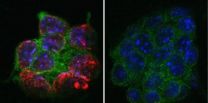(Press-News.org) A new study out today (Sunday 30 September) reveals that the emergence and spread of a rapidly evolving invasive intestinal disease, that has a significant mortality rate (up to 45%) in infected people in sub-Saharan Africa, seems to have been potentiated by the HIV epidemic in Africa.
The team found that invasive non-Typhoidal Salmonella (iNTS) disease is caused by a new form of the bacteria Salmonella Typhimurium that has spread from two different focal hubs in Southern and Central Africa beginning 52 and 35 years ago, respectively. They also found that one of the major contributing factors for the successful spread of iNTS was the acquisition of genes that afford resistance to several front line drugs used to treat blood-borne infection such as iNTS.
iNTS is a blood-borne infection that kills approximately one of four people in sub-Saharan Africa who catch it. Yet, in the rest of the world, NTS is a leading cause of acute inflammatory diarrhoea that is self-limiting and tends to be fatal in less than 1 per cent of people infected. The disease is more severe in sub-Saharan Africa than the rest of the world because of factors such as malnutrition, co-infection with malaria or HIV and potentially the novel genotype of the Salmonella bacteria.
"The immune system susceptibility provided by HIV, malaria and malnutrition at a young age, may provide a population in sub-Saharan Africa that is large enough for this detrimental pathogen to enter, adapt, circulate and thrive," says Chinyere Okoro, joint first author from the Wellcome Trust Sanger Institute. "We used whole genome sequencing to define a novel lineage of Salmonella Typhimurium that is causing a previously unrecognised epidemic across the region. Its genetic makeup is evolving into a more typhoid like bacteria, able to efficiently spread around the human body"
From sequenced samples, the team created a phylogenetic or 'family tree', depicting the pathogen's evolution, dating when each sample first emerged and overlaying this with geographical information about where these samples came from. They found that this invasive disease comprises of two very closely related waves; the first wave originated from a possible south-eastern hub, about 52 years ago and the second originated about 35 years ago, possibly from the Congo Basin.
"The HIV epidemic in sub-Saharan Africa is thought to have begun in a central region and underwent expansion eastwards, a strikingly similar dynamic to that observed for second iNTS wave," says Dr Robert Kingsley, joint first author from the Wellcome Trust Sanger Institute. "Our findings suggest the current epidemic of iNTS and its transmission across sub-Saharan Africa may have been potentiated by an increase in the critical population of susceptible, immune-compromised people."
The team identified that the vast majority of samples from the second wave of iNTS contains a gene that makes them resistant to chloramphenicol, a frontline antibiotic in the treatment of Salmonella. This gene was not present in the samples from the first wave of iNTS. This observation suggests that iNTS acquired this gene early on in the evolution of the second wave, probably around the time of its spread from the Congo basin.
"Because it acquired resistance to chloramphenicol, this pathogen has much greater opportunity to survive and spread across the region," says Professor Gordon Dougan, lead author from the Wellcome Trust Sanger Institute. "This is the first time that the power of whole-genome sequencing has been used to track the spread of iNTS. Our research highlights the power this approach has to monitor the emergence and spread of dangerous pathogens both locally and globally over time."
"There has been some evidence that this disease can be passed from human to human. Now the race is on to discover how NTS is actually transmitted in sub-Saharan Africa so that effective intervention strategies can be implemented."
### Notes to Editors
Publication Details
Chinyere K. Okoro, Robert A. Kingsley, Thomas R. Connor et al. 'Intra-continental spread of human invasive Salmonella Typhimurium pathovariants in sub-Saharan Africa'
Published in Nature Genetics 30 September 2012. DOI: 10.1038/ng.2423
Funding
This work was funded by the Wellcome Trust and Tropical Research Fellowship from the Wellcome Trust and Clinical Research Fellowship from GlaxoSmithKline.
Participating Centres
Wellcome Trust Sanger Institute, Wellcome Trust Genome Campus, Hinxton Cambridge, UK. CB10 1SA
Mahidol-Oxford Tropical Medicine Research Unit, Faculty of Tropical Medicine, Mahidol University, Bangkok, Thailand
Department of Clinical Infection, Microbiology and Immunology, Institute for Infection and Global Health, University of Liverpool, Liverpool, UK
Centre for Microbiology Research, Kenya Medical Research Institute, Nairobi, Kenya
Malawi-Liverpool-Wellcome Trust Clinical Research Program, University of Malawi College of Medicine, Blantyre, Malawi
Department of Microbiology, College of Medicine, University of Malawi, Blantyre, Malawi
Department of Gastroenterology, Institute of Translational Medicine, Liverpool University, Liverpool, UK. L69 3GE
Health Protection Agency, Laboratory for Gastrointestinal Infections, Centre for Infections, London, United Kingdom
Norwich Medical School, University of East Anglia, Norwich, United Kingdom
Cellular and Molecular Medicine, School of Medical Sciences, University of Bristol, Bristol, United Kingdom
Division of Paediatric Infectious Diseases, Department of Paediatrics and Human Development, Michigan State University, East Lansing, MI 48824, USA
National Hospital Abuja, Plot 132 Central District (Phase II), Garki Abuja, Nigeria
Barcelona Centre for International Health Research (CRESIB, Hospital Clínic-Universitat de Barcelona), Barcelona, Spain
Centro de Investigação em Saúde de Manhiça (CISM), Manhiça, Mozambique
Instituto Nacional de Saúde, Ministerio de Saúde, Maputo, Mozambique
Novartis Vaccines Institute for Global Health S.r.l. (NVGH), Via Fiorentina 1, 53100 Siena, Italy
MRC Centre for Immune Regulation, School of Immunity and Infection, College of Medicine and Dental Sciences, University of Birmingham, Birmingham, B15 2TT, UK.
Center for Vaccine Development, University of Maryland, Baltimore, HSFI 480, 685 West Baltimore St., Baltimore, MD 21201, USA
Department of Medicine, University of Maryland, Baltimore, HSFI 480, 685 West Baltimore St., Baltimore, MD 21201, USA
Selected Websites
The Wellcome Trust Sanger Institute is one of the world's leading genome centres. Through its ability to conduct research at scale, it is able to engage in bold and long-term exploratory projects that are designed to influence and empower medical science globally. Institute research findings, generated through its own research programmes and through its leading role in international consortia, are being used to develop new diagnostics and treatments for human disease.
http://www.sanger.ac.uk
The Wellcome Trust is a global charitable foundation dedicated to achieving extraordinary improvements in human and animal health. We support the brightest minds in biomedical research and the medical humanities. Our breadth of support includes public engagement, education and the application of research to improve health. We are independent of both political and commercial interests.
http://www.wellcome.ac.uk
Contact details
Don Powell Media Manager
Wellcome Trust Sanger Institute
Hinxton, Cambridge, CB10 1SA, UK
Tel +44 (0)1223 496 928
Mobile +44 (0)7753 7753 97
Email press.office@sanger.ac.uk
End of Notes to Editors
New pathogen epidemic identified in sub-Saharan Africa
Researchers track the spread of human invasive non-Typhoidal Salmonella in sub-Saharan Africa
2012-10-01
ELSE PRESS RELEASES FROM THIS DATE:
Climate change could cripple southwestern forests
2012-10-01
Combine the tree-ring growth record with historical information, climate records, and computer-model projections of future climate trends, and you get a grim picture for the future of trees in the southwestern United States. That's the word from a team of scientists from Los Alamos National Laboratory, the U.S. Geological Survey, the University of Arizona, and other partner organizations.
If the Southwest is warmer and drier in the near future, widespread tree death is likely and would cause substantial changes in the distribution of forests and of species, the researchers ...
Common RNA pathway found in ALS and dementia
2012-10-01
Two proteins previously found to contribute to ALS, also known as Lou Gehrig's disease, have divergent roles. But a new study, led by researchers at the Department of Cellular and Molecular Medicine at the University of California, San Diego School of Medicine, shows that a common pathway links them.
The discovery reveals a small set of target genes that could be used to measure the health of motor neurons, and provides a useful tool for development of new pharmaceuticals to treat the devastating disorder, which currently has no treatment or cure.
Funded in part by ...
The genetics of white finger disease
2012-10-01
Vibration-induced white finger disease (VWF) is caused by continued use of vibrating hand held machinery (high frequency vibration >50 Hz), and affects tens of thousands of people. New research published in BioMed Central's open access journal Clinical Epigenetics finds that people with a genetic polymorphism (A2191G) in sirtuin1 (SIRT1), a protein involved in the regulation of endothelial NOS (eNOS), are more likely to suffer from vibration-induced white finger disease.
VWF (also known as hand arm vibration syndrome (HAVS)) is a secondary form of Raynaud's disease involving ...
Breast cancer recurrence defined by hormone receptor status
2012-10-01
Human epidermal growth factor (HER2) positive breast cancers are often treated with the same therapy regardless of hormone receptor status. New research published in BioMed Central's open access journal Breast Cancer Research shows that women whose HER2 positive cancer was also hormone (estrogen and progesterone) receptor (HR) negative had an increased risk of early death, and that their cancer was less likely to recur in bone than those whose cancer retained hormone sensitivity.
Breast cancer is a heterogeneous disease with many different subtypes. HR positive cancer ...
Scientists find missing link between players in the epigenetic code
2012-10-01
CHAPEL HILL, N.C. – Over the last two decades, scientists have come to understand that the genetic code held within DNA represents only part of the blueprint of life. The rest comes from specific patterns of chemical tags that overlay the DNA structure, determining how tightly the DNA is packaged and how accessible certain genes are to be switched on or off.
As researchers have uncovered more and more of these "epigenetic" tags, they have begun to wonder how they are all connected. Now, research from the University of North Carolina School of Medicine has established ...
Blocking key protein could halt age-related decline in immune system, Stanford study finds
2012-10-01
STANFORD, Calif. — The older we get, the weaker our immune systems tend to become, leaving us vulnerable to infectious diseases and cancer and eroding our ability to benefit from vaccination. Now Stanford University School of Medicine scientists have found that blocking the action of a single protein whose levels in our immune cells creep steadily upward with age can restore those cells' response to a vaccine.
This discovery holds important long-term therapeutic ramifications, said Jorg Goronzy, MD, PhD, professor of rheumatology and immunology and the senior author of ...
Noninvasive measurement enables use of IFP as potential biomarker for tumor aggressiveness
2012-10-01
PHILADELPHIA — Researchers validated a method of noninvasive imaging that provides valuable information about interstitial fluid pressure of solid tumors and may aid in the identification of aggressive tumors, according to the results of a study published in Cancer Research, a journal of the American Association for Cancer Research.
Many malignant solid tumors generally develop a higher interstitial fluid pressure (IFP) than normal tissue. High IFP in tumors may cause a reduced uptake of chemotherapeutic agents and resistance to radiation therapy. In addition, a high ...
Mayo Clinic physicians ID reasons for high cost of cancer drugs, prescribe solutions
2012-10-01
ROCHESTER, Minn. -- A virtual monopoly held by some drug manufacturers in part because of the way treatment protocols work is among the reasons cancer drugs cost so much in the United States, according to a commentary by two Mayo Clinic physicians in the October issue of the journal Mayo Clinic Proceedings. Value-based pricing is one potential solution, they write.
VIDEO ALERT: Video of Dr. Rajkumar discussing the commentary is posted on the Mayo Clinic News Network.
Cancer care is not representative of a free-market system, and the traditional checks and balances that ...
Republican strength in congress aids super-rich, president's affiliation has no effect
2012-10-01
WASHINGTON, DC, September 27, 2012 — Republican strength in Congress increases the share of income held by the top 1 percent, but the president's political affiliation has no effect, suggests a new study in the October issue of the American Sociological Review that looks at the rise of the super-rich in the United States.
"This points to the central role that Congress has in the legislative process," said study co-author Thomas W. Volscho, an Assistant Professor of Sociology at CUNY-College of Staten Island. "The president has limited ability to make the sort of legislative ...
Patient-led advocacy has changed how US government funds medical research
2012-10-01
WASHINGTON, DC, September 27, 2012 — Patient-led advocacy has created a shift in the way the U.S. government has prioritized funding for medical research, and significantly changed the way policymakers think about who benefits the most from these dollars, a University of Michigan School of Public Health fellow in the Robert Wood Johnson Foundation Scholars in Health Policy Research Program found.
In "Disease Politics and Medical Research Funding: Three Ways Advocacy Shapes Policy," a paper published in the October issue of the American Sociological Review, Rachel Kahn ...
LAST 30 PRESS RELEASES:
Cannabis derivatives could provide new ovarian cancer treatments
Raising strong yeast as a petroleum substitute
Clues to the origin of hot Jupiters hidden in their orbits
Canada’s reduced pledge to Global Fund will impact domestic health
1 in 4 children with major traumatic injuries not cared for in pediatric trauma centres
Duke and Duke-NUS’ joint cross-population research to uncover "East-West" differences in disease and care
Scientists to ‘spy’ on cancer- immune cell interactions using quantum technology breakthrough
Tech savvy users have most digital concerns
Making lighter work of calculating fluid and heat flow
Normalizing blood sugar can halve heart attack risk
Lowering blood sugar cuts heart attack risk in people with prediabetes
Study links genetic variants to risk of blinding eye disease in premature infants
Non-opioid ‘pain sponge’ therapy halts cartilage degeneration and relieves chronic pain
AI can pick up cultural values by mimicking how kids learn
China’s ecological redlines offer fast track to 30 x 30 global conservation goal
Invisible indoor threats: emerging household contaminants and their growing risks to human health
Adding antibody treatment to chemo boosts outcomes for children with rare cancer
Germline pathogenic variants among women without a history of breast cancer
Tanning beds triple melanoma risk, potentially causing broad DNA damage
Unique bond identified as key to viral infection speed
Indoor tanning makes youthful skin much older on a genetic level
Mouse model sheds new light on the causes and potential solutions to human GI problems linked to muscular dystrophy
The Journal of Nuclear Medicine ahead-of-print tip sheet: December 12, 2025
Smarter tools for peering into the microscopic world
Applications open for funding to conduct research in the Kinsey Institute archives
Global measure underestimates the severity of food insecurity
Child survivors of critical illness are missing out on timely follow up care
Risk-based vs annual breast cancer screening / the WISDOM randomized clinical trial
University of Toronto launches Electric Vehicle Innovation Ontario to accelerate advanced EV technologies and build Canada’s innovation advantage
Early relapse predicts poor outcomes in aggressive blood cancer
[Press-News.org] New pathogen epidemic identified in sub-Saharan AfricaResearchers track the spread of human invasive non-Typhoidal Salmonella in sub-Saharan Africa


